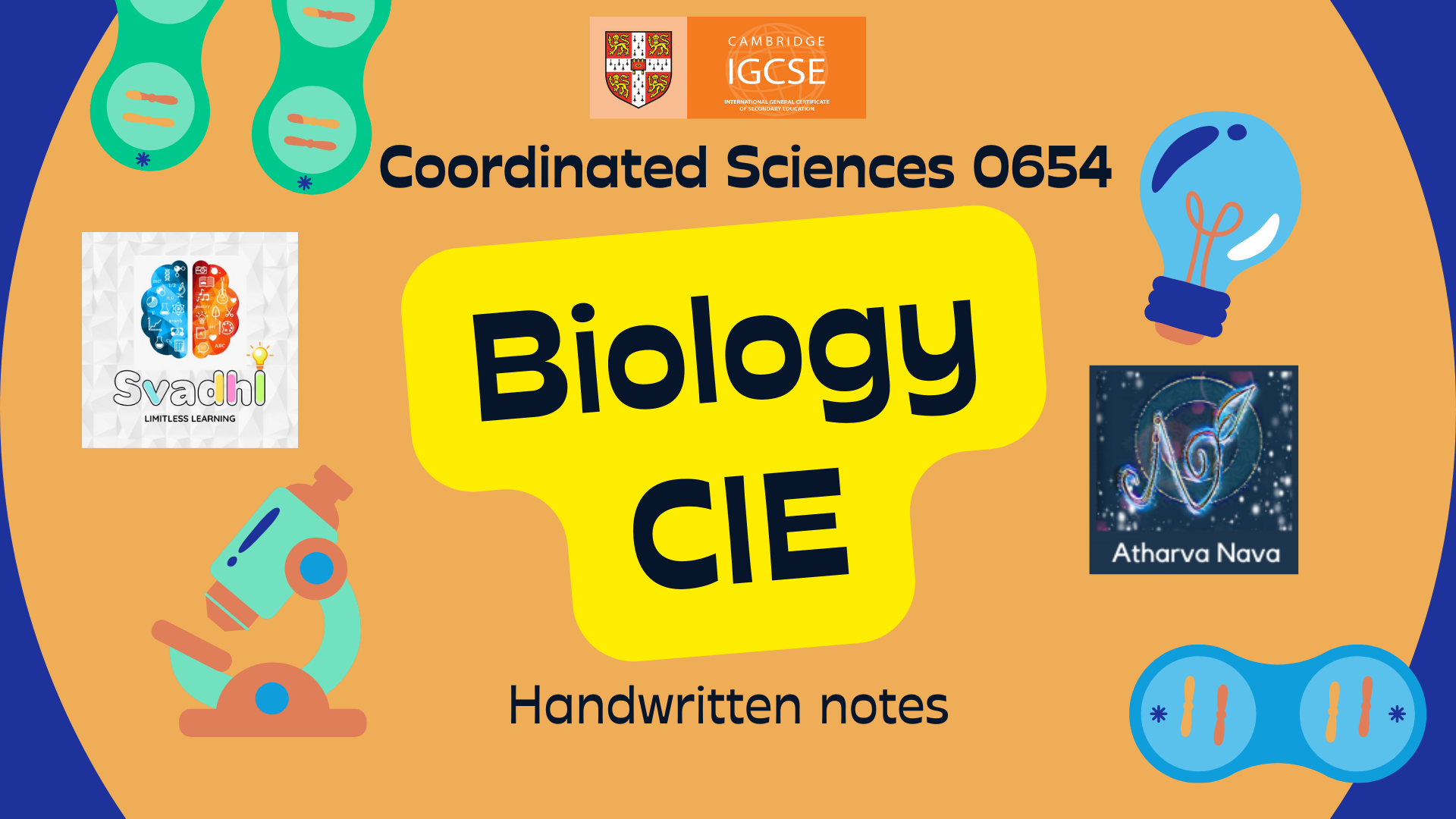IGCSE Biology revision just got easier! Handwritten notes and Graphics, chapter-wise downloads. Study smarter, not harder! Download Links in Red
Most of the diagrams/graphics can be credited to Save My Exams. We do not own these graphics.
Notes Pic is shown below for reference.
Author: Emma Le

B1. Characteristics of Living Organisms
- Movement
- Respiration
- Sensitivity
- Growth
- Reproduction
- Excretion
- Nutrition
B2.1. Cell structure
- characteristics of plant cells + animal cells
- magnification
- specialized cells
B2.2 Movement in and out of cells
- diffusion + factors affecting diffusion
- osmosis
- investigating osmosis
- effects of osmosis on plant and animal cells
- Carbohydrates
- simple, complex sugars
- Iodine test for starch
- Benedict’s test for reducing sugars
- Fats/lipids
- triglycerides
- ethanol emulsion test for fats + oils
- Proteins
- amino acids –> proteins
- Biuret test for proteins
- Water as a solvent
- enzyme, substrate, active site, enzyme-substrate complex, products
- factors affecting enzymes:
- temperature
- pH
- photosynthesis
- investigating the need for
- chlorophyll
- light
- CO2
- investigating the rate of photosynthesis
- light intensity
- temperature
- leaf structure and function
- photosynthesis
- gas exchange
- transport
- importance of magnesium and nitrate ions
B6.1. diet
- nutrients
- carbohydrates
- proteins
- fats/lipids
- vitamins (C, D)
- minerals (Ca, Fe)
- fibre
- water
- malnutrition:
- starvation, constipation, CHD, obesity
- Kwashiorkor, Marasmus
B6.2. Alimentary canal
- stages of food breakdown: ingestion –> digestion –> absorption –> assimilation –> egestion
- organs and functions
B6.3. Digestion
- mechanical digestion
- teeth decay
- chemical digestion
- enzymes
- villi
- the Circulatory system
- the heart
- coronary heart disease (CHD)
- investigating physical activity on pulse + heart rate
- blood vessels
- components of blood
B8. Gas exchange and Respiration
B8.1. Gas exchange
- gas exchange surfaces
- inspired vs expired air
- protecting the respiratory system
- effects of exercise on breathing
- tobacco smoking
B8.2. Respiration
- aerobic respiration
- anaerobic respiration in
- muscles
- yeast
B9.1. Nervous control in humans: CNS and PNS, types of neurons, the Reflex Arc
B9.2. Sense organs: the eye, the Pupil Reflex, fine-focussing = accommodation
B9.3. Hormones: adrenaline from adrenal glands, insulin from the pancreas
B9.4. Homeostasis: negative feedback, controlling blood glucose, body temperature, the skin
B9.5. Tropic responses: phototropism, gravitropism, plant hormone: auxin
B10.1-2. Asexual reproduction & Sexual reproduction in plants
B10.1. Asexual & sexual reproduction:
- virus (binary fission), plants (runners, bulbs, tubers)
- haploid cells, diploid cells, zygote
- advantages and disadvantages of either mode of reproduction
B10.2. Sexual reproduction in plants
- flower anatomy: sepal, petal, stamen, carpel
- pollination: wind and insect-pollinated plants; their adaptations
- fertilisation
- investigating conditions for germination: water, oxygen, warmth
B10.3. Sexual reproduction in humans
- anatomy of the
- male reproductive system: prostate glands, sperm ducts, urethra, penis, testis, scrotum
- female reproductive system: ovaries, oviducts, uterus, cervix, vagina
- fertilisation
- structural adaptations of the sperm and egg cells
- the menstrual cycle
- pregnancy:
- zygote, embryo
- functions of: amniotic sac, amniotic fluid, umbilical cord, placenta
- STIs & HIV/AIDS
- how they spread
- how to control their spread
B11.1 Chromosomes and genes
- inheritance
- chromosome, gene, DNA, allele
- haploid, diploid
B11.2. Cell division
- mitosis
- meiosis: reduction division
B11.3. Monohybrid inheritance
- genotype & phenotype
- homozygous & heterozygous
- dominant & recessive
- genetic diagrams, Punnett Squares
B11.4. Variation and Selection
- variation: continuous and discontinuous
- mutation
- natural selection –> evolution
- selective breeding (artificial selection)
B12. Organisms and their Environment
- food chain, food web
- producer, consumer
- herbivore, carnivore, decomposer
- ecosystem, trophic level
- energy transfer between trophic levels
B13. Human influences on ecosystems
- the Carbon cycle
- deforestation:
- extinction of species/ loss of biodiversity
- soil erosion
- flooding
- increase in atmospheric CO2
- water pollution
- eutrophication

